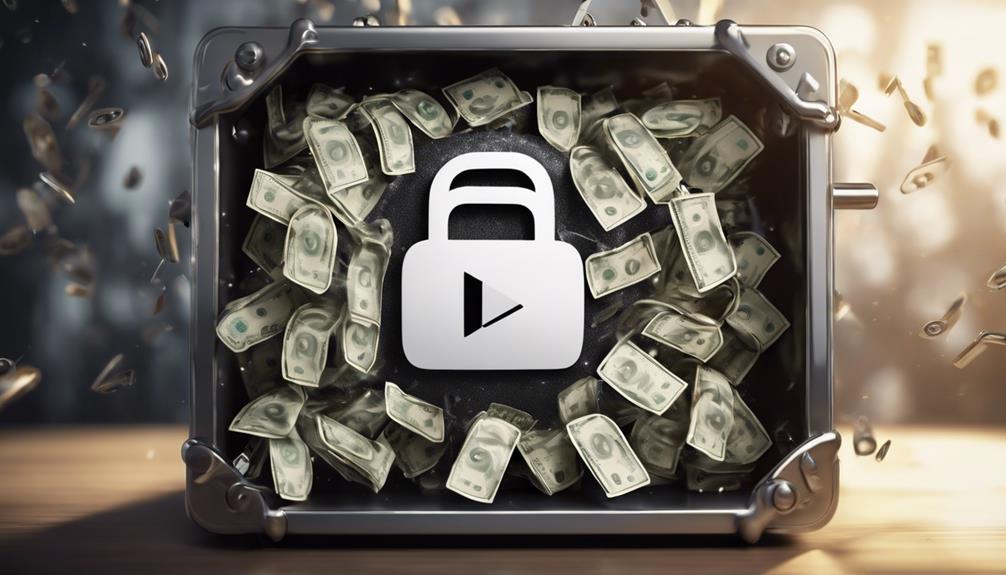
Do private videos affect monetization?
Just like Midas’ touch turned everything to gold, you might be wondering if private videos have the same ability to bring in revenue in the world of social media monetization.
You’re no stranger to the fact that public videos can generate income through ad revenue, sponsorships, and more. But what happens when you set your content to private?
Does the potential for financial gain disappear, or is there a hidden goldmine waiting to be discovered?
Hold that thought, let’s explore this intriguing aspect together.
Key Takeaways
- Private videos significantly affect monetization by limiting views, ad impressions, and potential ad revenue.
- Privacy settings on content can impact user engagement, channel growth, and overall watch time.
- Monetizing private videos can be achieved through subscription-based premium content.
- Balancing private and public content is essential to maintain a steady revenue stream and audience engagement.
Understanding Video Monetization

To fully grasp the impact of private videos on monetization, it’s crucial to first understand what video monetization entails and how it functions as a potential revenue stream. Essentially, video monetization is the process of earning revenue from your video content. This is typically achieved through ad revenue, sponsorships, or paid subscriptions.
Monetization strategies differ depending on the platform and the nature of the content. On YouTube, for example, you can earn ad revenue through the YouTube Partner Program, or you can offer exclusive content to paid subscribers through channel memberships. However, regardless of the platform or strategy, successful video monetization often hinges on Video SEO – optimizing your video content to rank higher in search results, thereby attracting more views and, in turn, more revenue.
It’s important to remember that monetization isn’t a one-size-fits-all process. What works for one creator or brand mightn’t work for another. That’s why it’s vital to experiment, innovate, and find the strategy that best fits your unique content and audience. So, as you venture into the world of video monetization, keep these points in mind.
The Concept of Private Videos
Diving into the realm of private videos, it’s essential you understand these are videos intentionally made inaccessible to the general public, thereby affecting their potential for monetization. This private accessibility is a feature on many digital platforms, allowing creators to control who views their content. It’s a delicate balance, as video privacy might safeguard the content, but it also limits the audience reach, thereby reducing earning potential.
To help you grasp this concept, let’s break it down in a simple table:
| Public Videos | Private Videos | |
|---|---|---|
| Accessibility | Accessible to anyone | Accessible only to permitted viewers |
| Monetization Potential | High, depending on views and ads | Low, due to limited viewership |
| Privacy | Low, visible to all | High, content is safeguarded |
Innovative solutions are required to overcome this dichotomy. One might consider offering premium content to a subscription-based audience, thereby maintaining privacy while also ensuring consistent revenue. Remember, while private videos preserve the integrity of your content, they also limit your monetization potential. Hence, you should carefully consider your privacy settings before uploading.
Monetization Rules on YouTube

You must grasp YouTube’s monetization policy to fully comprehend how private videos affect monetization.
The eligibility criteria for monetization is crucial in this context.
We’ll also examine the impact of private videos on your potential earnings.
Understanding YouTube Monetization Policy
Navigating the labyrinth of YouTube’s monetization policy can seem daunting, but it’s crucial for understanding how private videos affect your earnings. YouTube’s policy is a complex web of rules that are designed to protect both creators and advertisers, but it can also bring up monetization pitfalls that you need to be aware of.
- Monetization Pitfalls: Understand that not all content is eligible for monetization, even if it complies with YouTube’s guidelines.
- Navigating YouTube’s Policy: Be aware of the ever-changing nature of these guidelines, and always stay updated.
- Revenue Diversification: To mitigate risks, consider diversifying your income streams beyond YouTube ads.
Understanding these aspects will help you make informed decisions, minimizing potential disruptions to your revenue stream.
Eligibility Criteria for Monetization
Before exploring the specifics of private videos, let’s first get a clear grasp of the eligibility criteria for monetization on YouTube. To monetize, you’ve got to navigate a few monetization barriers.
Here’s a quick rundown:
| Eligibility Criteria | Details |
|---|---|
| Channel’s Subscriber Count | At least 1,000 subscribers |
| Watch Hours | 4,000 public watch hours in the last 12 months |
| AdSense Account | Link a valid AdSense account |
| Compliance | Follow all of YouTube’s policies and guidelines |
| Geographical Location | Live in a country where the YouTube Partner Program is available |
Overcoming these hurdles opens up sponsorship opportunities and ad revenue. However, it’s not enough to meet the criteria; maintaining them is equally vital. YouTube regularly reviews channels to ensure ongoing compliance. So, while striving for monetization, remember, consistency and compliance are key.
Impact of Private Videos
Diving into the realm of private videos, it’s crucial to understand how these hidden-from-public-view videos can significantly impact your channel’s monetization potential on YouTube.
- Private streaming: Private videos aren’t included in YouTube’s monetization. You’re restricting access to a limited audience, which deflates your potential ad revenue. It’s like having a brilliant product, but keeping it under wraps.
- Video privacy settings: The more public your videos, the more views and increased ad impressions you garner. Switching to private reduces this drastically.
- User engagement: Private videos don’t allow user interaction such as likes, comments, or shares. This hampers your channel’s growth and engagement rates, both crucial for monetization.
In a nutshell, private videos can be a double-edged sword. Use them wisely to maintain a balance between privacy and monetization.
Private Videos: Impact on Earnings

While you may consider private videos as a means to control your content, it’s crucial to understand that they’ve a significant impact on your potential earnings. In fact, private livestreams and unlisted videos aren’t publicly accessible, which drastically reduces the number of potential views and, consequently, your ad revenue.
In terms of YouTube’s monetization policy, private videos aren’t eligible for ads, and therefore, no ad revenue can be generated from them. On the other hand, unlisted videos can generate ad revenue, but their visibility is still limited, affecting your potential earnings.
Furthermore, private videos don’t contribute to your channel’s overall watch time, a key factor in YouTube’s algorithm for promoting content and determining ad placements. This means that the more private videos you have, the less likely your other content is to be recommended to viewers, which can limit your channel’s overall growth.
Facebook Monetization Policies
Shifting gears to Facebook, it’s essential to understand their monetization policies as they significantly influence how you can earn from the platform. Facebook’s monetization strategies, including Ad Breaks Strategy and In-Stream Ads Impact, are critical for you to maximize your earnings.
- Ad Breaks Strategy: Facebook allows you to insert ads into your videos, providing a revenue stream. However, the placement and frequency of these ad breaks significantly affect viewer engagement and retention. Therefore, it’s crucial to strike a balance between maximizing ad revenue and maintaining a positive viewer experience.
- In-Stream Ads Impact: These ads are inserted in your video streams and can generate additional revenue. However, the content of your video plays a significant role in determining the number of in-stream ads that can be placed without disrupting the viewer’s experience.
- Content Eligibility: Not all content is eligible for monetization. Facebook has specific content guidelines that must be adhered to. Violating these guidelines can lead to loss of monetization privileges.
Understanding and effectively implementing these policies can be the difference between a lucrative Facebook presence and an unsuccessful one. Therefore, it’s worth investing the time to grasp these rules thoroughly.
Vimeo and Monetization

Now, let’s turn our attention to Vimeo, another video-sharing platform that offers unique monetization opportunities you should consider. Unlike many other platforms, Vimeo provides you with several subscription models to choose from. Each of these models offers different benefits and revenue streams, so it’s crucial to understand them to maximize your earnings.
Firstly, Vimeo Plus, Pro, and Business subscriptions provide you with a host of features that can boost your video content’s reach and potential profitability. These features, ranging from high-quality streaming to powerful privacy settings, allow you to control how and when your content is viewed.
However, you should also be aware of copyright issues on Vimeo. Vimeo has a strict copyright policy, and any violation can result in penalties, including the removal of your content. It’s essential to ensure that all the content you upload is original or that you have the necessary permissions to use any third-party material.
Ads and Private Videos
Let’s now turn our attention to the intersection of ads and private videos.
You’ll need to comprehend YouTube’s ad policies and how they affect the monetization of private videos.
This knowledge is crucial, as it directly impacts your revenue stream.
Understanding YouTube Ad Policies
To fully grasp the impact of private videos on monetization, you need to first understand YouTube’s ad policies regarding these types of videos. YouTube’s ad policies are designed to ensure a fair playing field for all, including creators, advertisers, and viewers.
There are three main aspects you should pay attention to:
- Ad Placement Strategies: YouTube’s algorithms determine ad placements based on video content, viewer behavior, and advertiser requirements.
- Influencer Partnerships: YouTube encourages creators to partner with brands and advertisers, but such collaborations must adhere to YouTube’s guidelines.
- Private Videos: These are invisible to the public and advertisers, hence they can’t be monetized through ads.
Understanding these policies can help you develop innovative strategies to maximize your YouTube revenue.
Monetization of Private Videos
In light of YouTube’s ad policies, it becomes clear why private videos – hidden from both public and advertiser view – are unable to generate revenue through traditional ad placements. Your Video Privacy Settings matter. If a video is marked private, it’s invisible to both the viewing public and advertisers. This means no ad placements, no clicks, and inevitably, no monetization.
But there’s more to monetization techniques than just ads. Even though private videos don’t cater to the traditional ad revenue model, they can be employed in innovative ways to generate income. They can be a part of paid memberships, special content for VIP subscribers, or used in crowdfunding campaigns.
Hence, while private videos aren’t ad-friendly, they aren’t necessarily devoid of monetization potential.
Impact on Revenue Stream
Understanding the impact of private videos on your revenue stream requires a deep dive into the intricacies of YouTube’s advertising system. Private videos, unviewable by the general public, don’t generate ad revenue and can disrupt your sustainable monetization approach.
Here’s how it affects:
- Reduced Ad Impressions: With fewer public videos, there are fewer opportunities for ads, affecting your earnings directly.
- Audience Limitation: Private videos limit the scope of reaching a wider audience, stifling revenue diversification.
- Potential Subscriber Loss: If most of your content is private, subscribers may lose interest, leading to a decrease in views and, consequently, revenue.
While considering a balance between private and public content, remember, innovation is key to maintaining an active, engaged audience and a steady revenue stream.
Patreon: A Unique Approach
Dipping your toes into the world of Patreon can provide a novel monetization avenue for your private videos. The Patreon benefits are numerous, offering a unique platform that allows you to connect with your audience on a deeper level. By providing exclusive content to your patrons, you’re able to foster a sense of community while also generating steady income.
Patreon’s crowdfunding potentials are a game-changer. Unlike ad revenue, which is unpredictable and often minimal, Patreon allows you to set up different tiers of support. This means you’re able to offer varying levels of access and rewards to your patrons based on their level of contribution. This model not only motivates your audience to contribute more, but it also ensures a reliable stream of income.
The beauty of Patreon lies in its simplicity and flexibility. You can tailor your content and rewards to fit your audience’s needs and desires. As long as you’re consistent and provide value, your patrons will keep coming back for more. It’s a win-win situation that allows you to continue creating, while also securing the necessary funds to do so.
Exploring Other Video Platforms

Beyond Patreon, it’s worth considering other video platforms to expand your monetization strategies. Exploring emerging platforms can open up new revenue streams for content creators like yourself. Given the rapidly evolving digital landscape, it’s crucial to stay ahead of the curve and capitalize on innovative opportunities.
- TikTok: This platform has exploded in popularity, significantly among the younger demographic. TikTok monetization allows creators to earn from gifts during live streams, brand partnerships, and more recently, the TikTok Creator Fund.
- YouTube: With its Partner Program, YouTube offers monetization through ad revenue, channel memberships, and Super Chat during live streams.
- Facebook Video: Facebook’s Ad Breaks enable you to earn money from ads inserted into your videos.
Maximizing Revenue From Videos
To truly maximize your video revenue, it’s essential to leverage the power of platform-specific monetization strategies and create content that resonates with your target audience. Revenue diversification is a critical aspect of this approach. Instead of relying solely on advertising revenue, consider integrating merchandise sales, crowdfunding, or subscription models into your strategy. This type of diversification mitigates risks and provides a more consistent income stream.
Moreover, don’t dismiss sponsorship opportunities. Brands are increasingly seeking influencers and content creators to promote their products. Sponsorships can serve as a significant revenue source, particularly if your content aligns with the sponsor’s target demographic. However, ensure these partnerships feel authentic to maintain your audience’s trust.
Case Study: Successful Monetization Strategies

Let’s examine some real-life examples that illustrate successful monetization strategies in action. Despite the monetization challenges that private YouTube videos pose, these cases show how innovation and strategic planning can spur revenue diversification and growth.
- Patreon: This platform has revolutionized monetization for creators by providing them with a membership-based model. Here, creators offer exclusive content to their patrons, who pay a subscription fee. This method hasn’t only diversified revenue but also built a more intimate community.
- Course Creation: Educators and experts have turned to creating private video courses. They sell these courses on platforms like Udemy, which has allowed them to monetize their expertise and diversify their income.
- Brand Partnerships: Influencers often create private sponsored videos for brands. These videos, while not accessible to the general public, generate substantial revenue from brand collaborations.
Each of these strategies shows that private videos don’t have to be a barrier to monetization. On the contrary, they can open up new avenues for revenue diversification. With careful planning and an innovative mindset, you too can overcome the challenges and successfully monetize your private videos.
Future Trends in Video Monetization
Looking ahead, you’ll find that the landscape of video monetization is poised for significant changes, driven by emerging technologies and evolving viewer expectations. Notably, two trends are shaping the future: Emerging Monetization Platforms and Blockchain based Monetization.
Emerging Monetization Platforms are creating opportunities for more diversified revenue streams. They’re not confined to traditional advertising. Instead, they’re incorporating in-video purchases, subscriptions, and crowd-funding. This trend is empowering you to be not just video creators, but also entrepreneurs.
On the other hand, Blockchain based Monetization is revolutionizing the way rewards are distributed among creators and viewers. With the transparency and security that blockchain technology offers, you can now benefit from a fairer, more decentralized monetization system.
To give you a clearer picture, let’s look at these trends in more detail:
| Emerging Monetization Platforms | Blockchain based Monetization |
|---|---|
| Diversified revenue streams | Decentralized rewards distribution |
| Empowering video creators | Transparency and security |
| Beyond traditional advertising | Fairer system |
| In-video purchases, subscriptions, crowd-funding | Revolutionizing reward distribution |
Embrace these trends and align your strategies accordingly. The future of video monetization is here, and it’s innovative, exciting, and full of opportunities.

